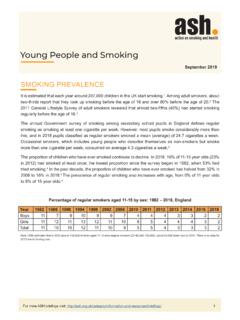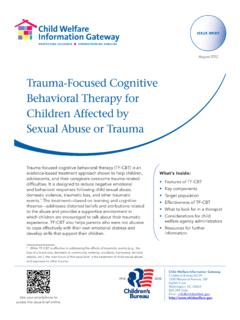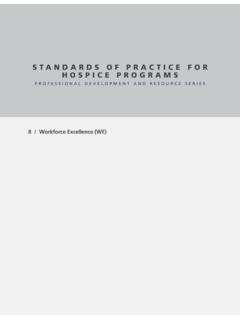Transcription of Hemolytic Anemia: Evaluation and Differential Diagnosis
1 354 American Family Physician Volume 98, Number 6 September 15, 2018 Hemolytic anemia is defined as the destruction of red blood cells (RBCs) before their normal 120-day life span. It includes many separate and diverse entities whose common clinical features can aid in the identification of hemolysis. Hemolytic anemia exists on a spectrum from chronic to life-threatening, and warrants consideration in all patients with unexplained normocytic or macrocytic destruction of RBCs can occur intravascu-larly or extravascularly in the reticuloendothelial sys-tem, although the latter is more common.
2 The primary extravascular mechanism is sequestration and phago-cytosis due to poor RBC deformability ( , the inabil-ity to change shape enough to pass through the spleen). Antibody-mediated hemolysis results in phagocytosis or complement-mediated destruction, and can occur intra-vascularly or extravascularly. The intravascular mecha-nisms include direct cellular destruction, fragmentation, and oxidation. Direct cellular destruction is caused by toxins, trauma, or lysis.
3 Fragmentation hemolysis occurs when extrinsic factors produce shearing and rupture of RBCs. Oxidative hemolysis occurs when the protective mechanisms of the cells are etiologies of hemolysis are numerous (Table 1). The hemoglobinopathies lead to splenic destruction and, in the case of sickle cell disease, likely multiple mechanisms of destruction. Inherited protein deficits lead to increased destruction in membranopathies. Enzymopathies result in hemolysis due to overwhelming oxidative stress or decreased energy production.
4 In immune-mediated hemo-lytic anemia, antibodies bind with the RBCs, resulting in phagocytosis or complement-mediated destruction. The extrinsic nonimmune causes include microangiopathic Hemolytic anemia (MAHA), infections, direct trauma, and drug-induced hemolysis, among PresentationHemolysis should be considered when a patient experiences acute jaundice or hematuria in the presence of anemia. Symptoms of chronic hemolysis include lymphadenopathy, hepatosplenomegaly, cholestasis, and choledocholithia-sis.
5 Other nonspecific symptoms include fatigue, dyspnea, hypotension, and tachycardia. Hemolytic Anemia: Evaluation and Differential DiagnosisJames Phillips, MD, and Adam C. Henderson, MD, Womack Army Medical Center, Fort Bragg, North CarolinaHemolytic anemia is defined by the premature destruction of red blood cells, and can be chronic or life-threatening. It should be part of the Differential Diagnosis for any normocytic or macrocytic anemia. Hemolysis may occur intravascularly, extravascularly in the reticuloendothelial system, or both.
6 Mechanisms include poor deformability leading to trapping and phagocytosis, antibody-mediated destruction through phagocytosis or direct complement activation, fragmentation due to microthrombi or direct mechanical trauma, oxidation, or direct cellular destruction. Patients with hemolysis may present with acute anemia, jaundice, hematuria, dyspnea, fatigue, tachycardia, and possibly hypotension. Laboratory test results that confirm hemolysis include reticulocytosis, as well as increased lactate dehydrogenase, increased unconju-gated bilirubin, and decreased haptoglobin levels.
7 The direct antiglobulin test further differentiates immune causes from nonimmune causes. A peripheral blood smear should be performed when hemolysis is present to identify abnormal red blood cell morphologies. Hemolytic diseases are classified into hemoglobinopathies, membranopathies, enzymopathies, immune-mediated anemias, and extrinsic nonimmune causes. Extrinsic nonimmune causes include the thrombotic micro-angiopathies, direct trauma, infections, systemic diseases, and oxidative insults. Medications can cause Hemolytic anemia through several mechanisms.
8 A rapid onset of anemia or significant hyperbilirubinemia in the neonatal period should prompt consideration of a Hemolytic anemia. (Am Fam Physician. 2018 ;98(6):354-361. Copyright 2018 American Acad-emy of Family Physicians.) CME This clinical content conforms to AAFP criteria for continuing medical education (CME). See CME Quiz on page 345. Author disclosure: No relevant financial from the American Family Physician website at Copyright 2018 American Academy of Family Physicians. For the private, noncom-mercial use of one individual user of the website.
9 All other rights reserved. Contact for copyright questions and/or permission 15, 2018 Volume 98, Number 6 American Family Physician 355 Hemolytic ANEMIAE valuationWhen hemolysis is suspected, the history should include known medical diagnoses, medications, personal or family history of Hemolytic anemia, and a complete review of sys-tems. The physical examination should focus on identifying associated conditions, such as infections or malignancies (Table 2).The initial workup of Hemolytic anemia begins with a complete blood count illustrating normocytic (mean cor-puscular volume of 80 to 100 m3 [80 to 100 f L]) or mac-rocytic (mean corpuscular volume greater than 100 m3) anemia (Fig u re 1).
10 When anemia is identified, testing should include measurement of lactate dehydrogenase, haptoglo-bin, reticulocyte, and unconjugated bilirubin levels, as well TABLE 1 Differential Diagnosis of HemolysisClass/typeDiseasesMechanismSite Laboratory testsTreatmentAlloimmuneTransfusion reactions, hemo-lytic disease of the fetus and newborn Trapping, phagocytosis, complementIntravascularNeonatal DATHalt transfusion, supportiveAutoimmune Hemolytic anemiaWarm or cold autoimmune Hemolytic anemiaTrapping, phagocytosis, complementExtravascular or intravascularDAT Steroids, avoid-ance, treatment of other diseaseDrug inducedDrug-induced thrombotic microangiopathy, drug-in-duced immune Hemolytic anemia, oxidative hemolysisDirect, toxin, phagocytosis, fragmentationExtravascular or intravascularSchistocytes, DAT, Heinz bodiesDrug withdrawalEnvenomationInsects, cobra, brown recluse spiderDirectExtravascular or intravascular EnzymopathyG6PD or pyruvate kinase deficienciesOxidative lysisIntravascularEnzyme activity measurementAvoidance.
















